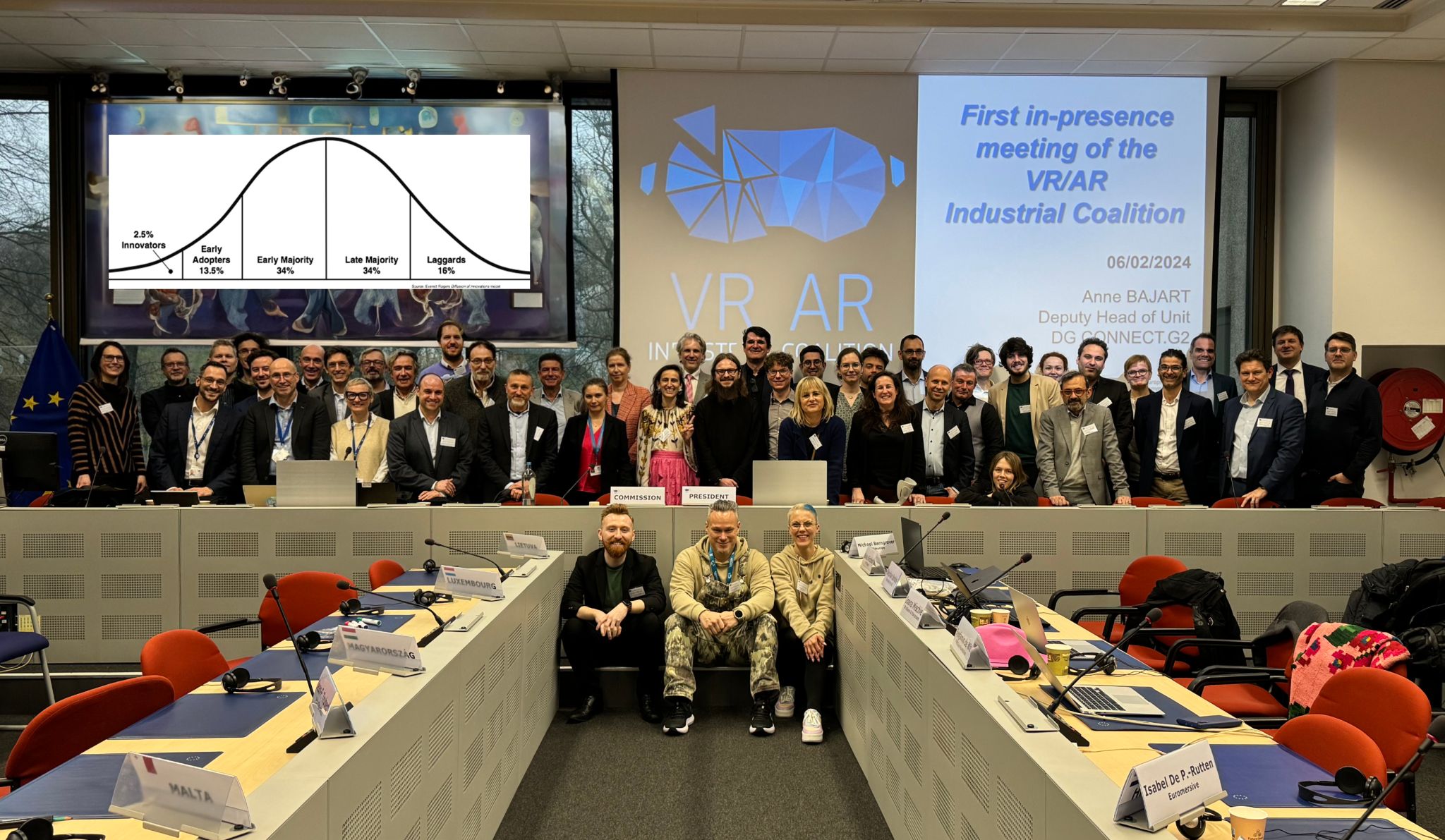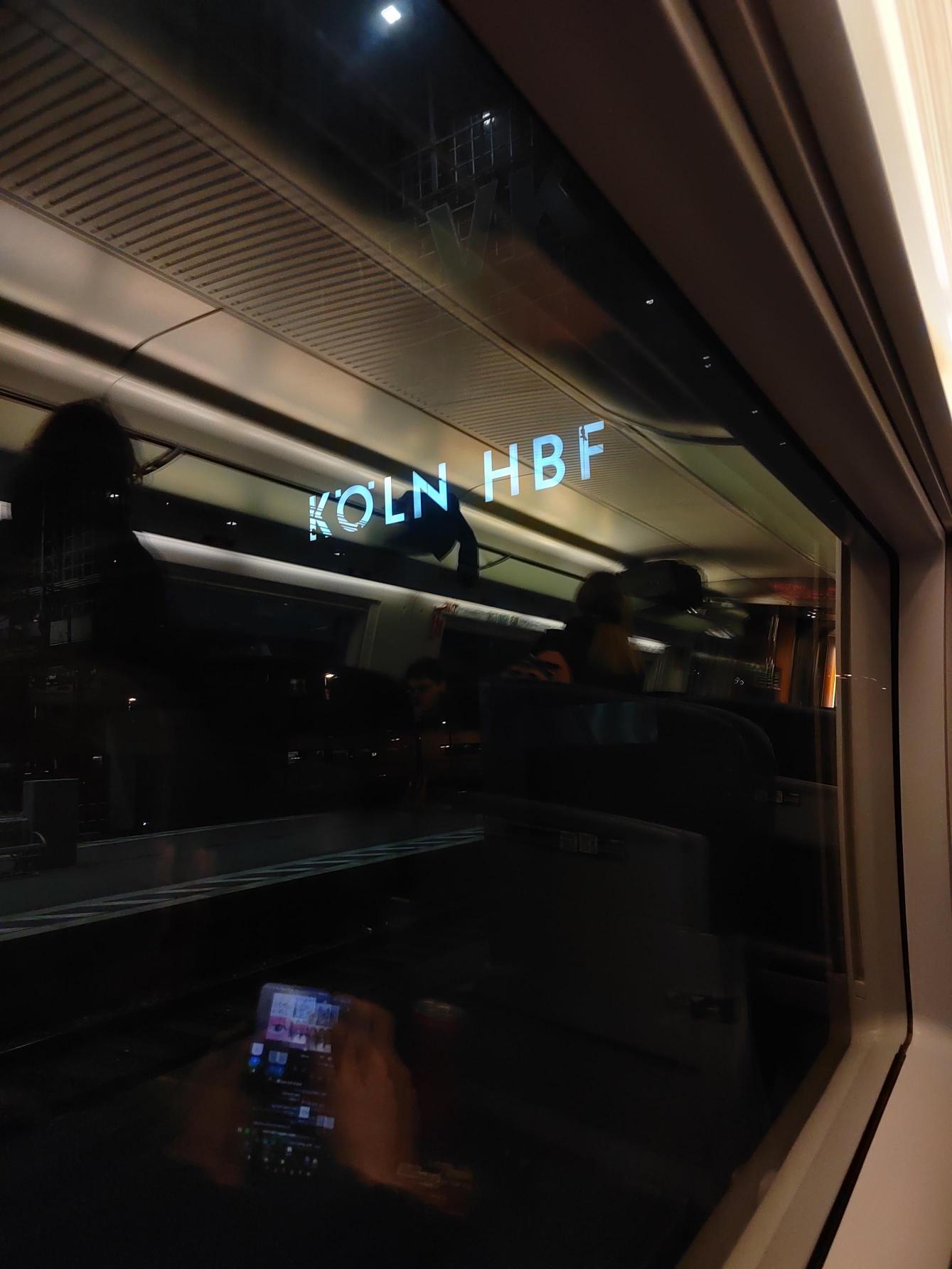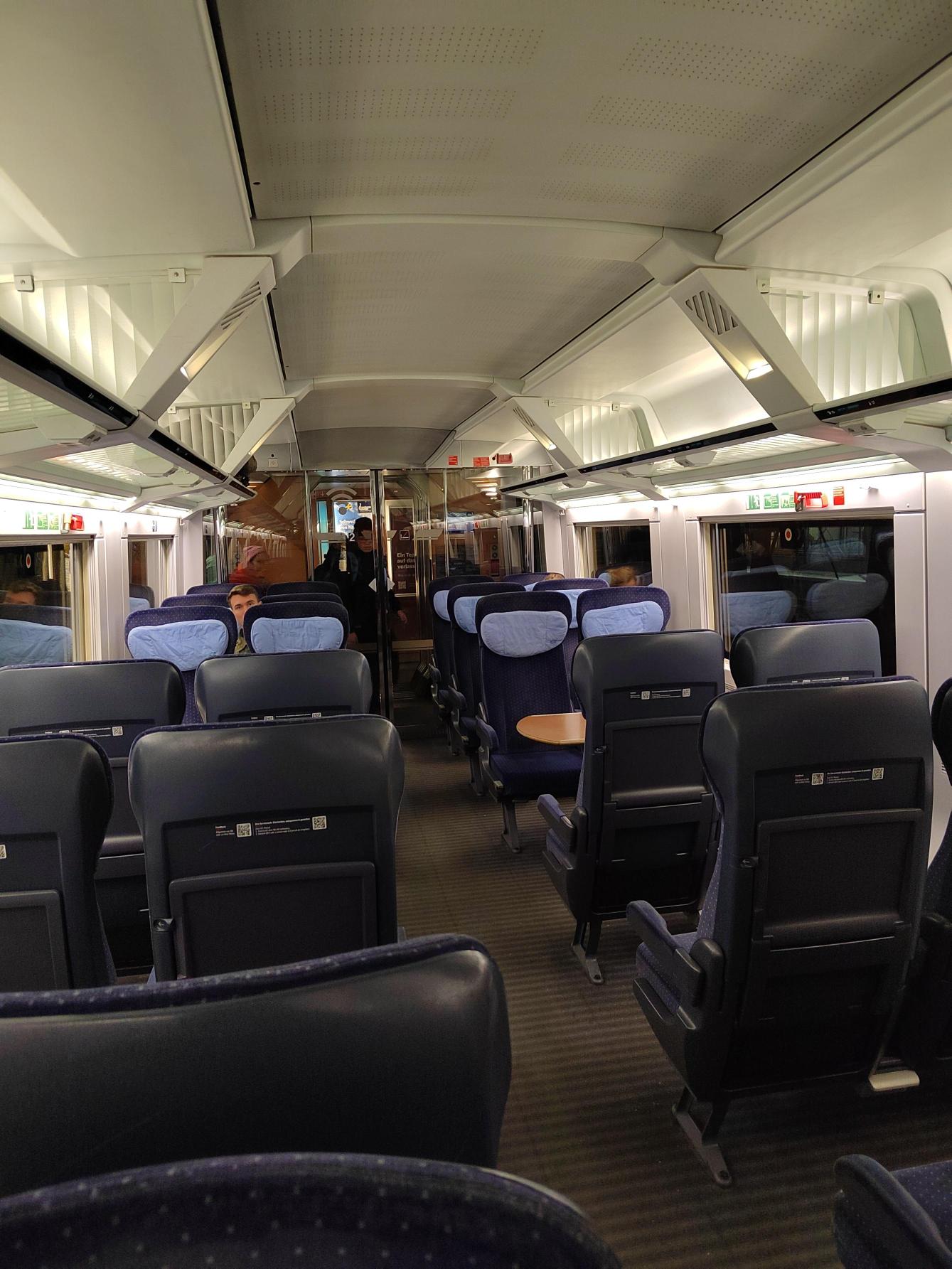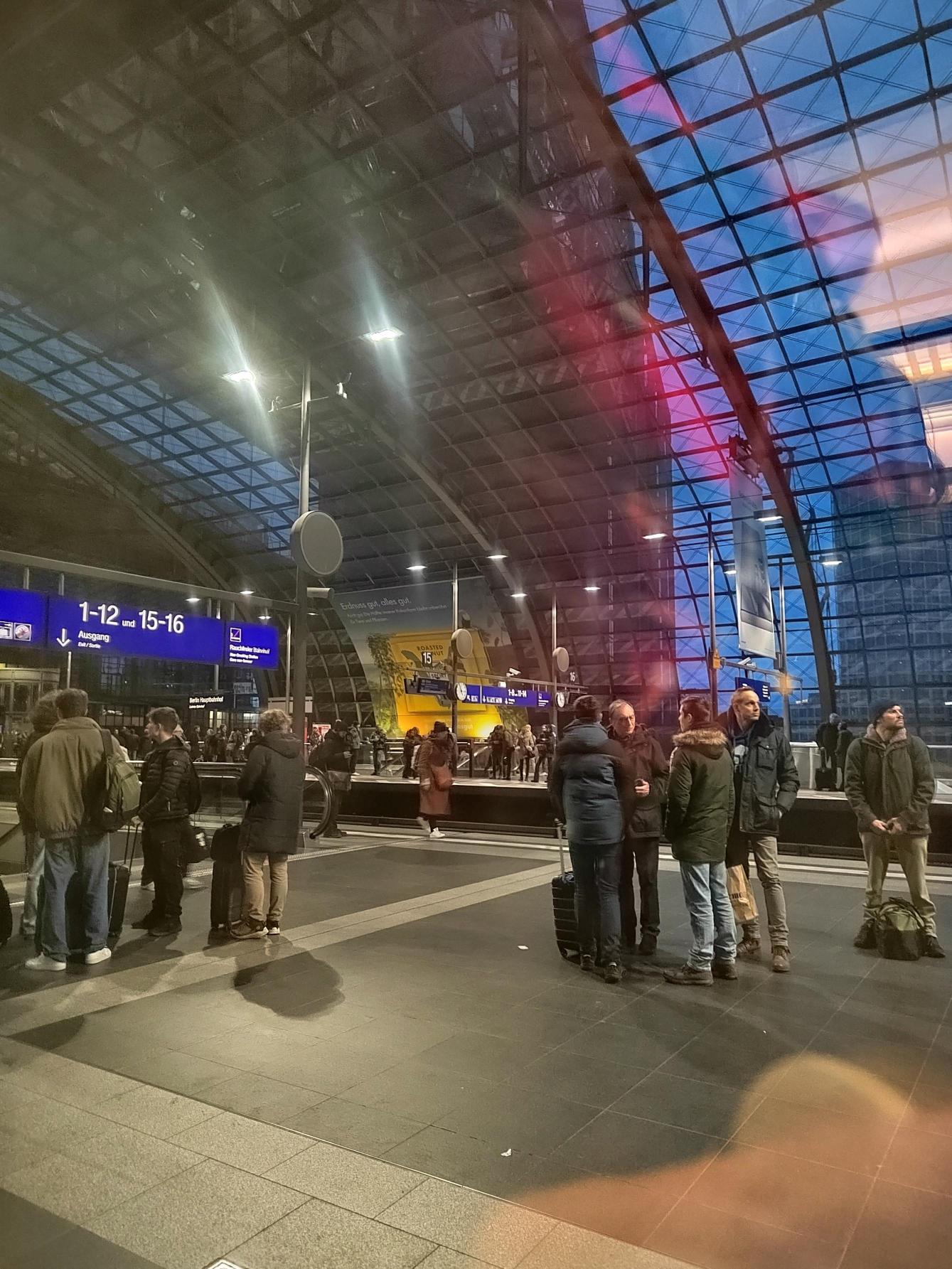Exploring Sustainable Paths & Digital Futures: Join the journey of our RDI Project Specialist Janina Rannikko to Brussels for the Research to Reality conference & VR/AR Industrial Coalition meeting. Discover insights on virtual worlds, digital competence in the EU, and reflections on eco-friendly travel from Helsinki.

Research to Reality opening session
Text and images by Janina Rannikko
I had the chance to travel to Brussels from February 5th to 6th, 2024, with environmental sustainability in mind, to participate in two significant events: the Research to Reality conference and the in-person meeting of the VR/AR Industrial Coalition. This article aims to share insights from these gatherings, update the XR community on the discussions and the projects status, alongside sharing reflections on my environmentally-friendly travel from Helsinki to Brussels.
Research to Reality – Digital Solutions to European Challenges
The core concept of the conference was forward-thinking, focusing on the transition of innovative research findings into practical applications and market integration. Another significant emphasis was on increasing the digital competitiveness of Europe. The opening session highlighted the importance of semiconductors and chip industry, closing the gap from lab to fab, ecosystem building, communicating Europe’s achievements more visibly, and the importance of commercialization. The panel discussion concluded that start ups need all help they can to scale up and risks should not be afraid. It is also important to create connections between people in different fields as Europe has fantastic networks of experts.
Alongside the discussions, we all enjoyed the real-time hand-drawn summary of the proceedings by the amazing artist Axelle Vanquaillie.

Axelle Vanquaillie’s live summary drawing of the opening keynotes.
The conference had three themed tracks with multiple sub-sessions: Roads from research to reality; Building technological leadership & strategic autonomy; and Funding strategies. I participated in presentations of ”Unlocking synergies: fostering collaborative innovation, Virtual worlds and web 4.0 and Human centric twin transition across European innovation programmes”.
The conference focused on the transition of innovative research findings into practical applications and market integration, as well as increasing the digital competitiveness of Europe .
It is also important to create connections between people in different fields as Europe has fantastic networks of experts.
Unlocking synergies session highlighted the Ideal-ist project that offers services for funding calls by introducing tools like Topic Tree, Partner Search and pre-proposal checks.

Panel discussion on virtual worlds.
Virtual worlds & Web 4.0 panel discussed the human centric system and how commercial companies need to convince their clients by showcasing pilots, creating hype and adopting new ideas and technology. Another critical topic addressed the misuse of virtual worlds through harassment, identity theft and hate speech; while one of the possible proposed solutions was the adoption of a regulatory sandbox.
Twin transition session brought up different examples of sustainable solutions. It was highlighted that digital innovations actually have a greater impact on nature than previously thought. Hardly any digitalization processes optimize the economic, social and environmental sustainability at the same time. It is hard to estimate and to calculate the whole carbon footprint of digitalization processes.
Digital innovations have a greater impact on nature than previously thought. Hardly any digitalization processes optimize the economic, social and environmental sustainability at the same time. It is hard to estimate and to calculate the whole carbon footprint of digitalization processes.
In the closing session of the day, Europe’s strategic autonomy, ecological footprint, utilizing artificial intelligence, citizen’s participation and the power of youth in the digital revolution were discussed. Other important points were the entrepreneurial mindset and how to foster it and that ecosystems are key to innovations.
I was delighted to note that many of the initiatives discussed are already in motion at the Helsinki XR Center.
I was delighted to note that many of the initiatives discussed are already in motion at the Helsinki XR Center. We put a lot of effort into fostering the Finnish XR ecosystem and its growth, we include young people in our projects through traineeships, we connect people from different disciplines and mindsets and lately we have also started to build something concrete towards sustainability.

Axelle Vanquaillie’s live summary drawing of the closing panel discussion.
VR/AR Industrial Coalition in person meeting
The VR/AR Industrial Coalition in person meeting took place in Albert Borschette Congress Center, which had an airport level security check before entering our meeting hall. The day consisted of insights of the work of the coalition, report of Zero distance XR -study, presentations of some of the community members and breakout session for the virtual worlds in Europe 2030.
EU Initiative on Web 4.0 and virtual worlds
Anne Bajart, the Deputy Head of Unit, presented the status of the EU Initiative on Web 4.0 and virtual worlds (implemented on February 2, 2024). The initiative is structured around four main areas: People and Skills, Business and Industrial Ecosystem, Government, and Governance.
In the People and Skills segment, a toolbox for virtual worlds will be launched on March 29, and a Horizon Europe Study on Virtual Worlds’ health and well-being is scheduled for Q1 2024. For the Business and Industrial Ecosystem, the HEurope Virtual Worlds Partnership proposal is awaiting approval by Member States.
Currently, there are 49 European Partnerships designed to foster collaboration between private and public entities, thus minimizing investment duplication and reducing the fragmentation of the EU’s research and innovation landscape. The Virtual Worlds Partnership aims to be a comprehensive and multidisciplinary entity that supports the development of a robust industrial and user ecosystem across the entire virtual worlds value chain, emphasizing active engagement with society.

Representing HXRC at the VR/AR Industrial Coalition meeting.
Partners in this initiative include a wide range of stakeholders from industry (large companies, SMEs, startups, spin-offs), academia (universities, research organizations), end-users (unions, consumer associations), and policymakers at all levels. The formation of an association, based on the VR/AR coalition and benefiting from collaborations like XR4EUROPE, NEM, and EUROXR, is crucial for representing these partners. This association will also encourage the involvement of existing groups such as XR4HUMAN and OPENVERSE and is open to all interested parties.
Key actions for establishing the European Partnership include mobilizing the community, linking with the ARVR Coalition, forming the private association, submitting the official partnership proposal, and signing the Memorandum of Understanding.
Breakout session: “Virtual Worlds in Europe 2030”
I also participated in the breakout session looking at the Virtual Worlds in Europe in 2030. During the session, the aim was to pinpoint actionable steps for addressing key societal and industrial challenges. Participants were divided into six groups, with half exploring societal issues and the other half focusing on industrial concerns.
In my societal aspect group, we explored inclusivity, accessibility, social equality, security, and the evolving requirements for jobs and skills. Other groups discussed related themes, including governance, usability, and fostering connections among people, highlighting a human-centric approach and the need for security regulations as overarching priorities. The outcomes from this breakout session are intended to guide the coalition’s future efforts.

Group photo of the participants.
Sustainable travel from Helsinki to Brussels
I had four motivators to test traveling by land. The most ambitious motivator was, of course, exploring sustainable travel options. Sustainability is, for example, one cornerstone of Metropolia’s strategy. The other three motivators were more self-centered. I’ve never liked flying, although I’ve done it more than enough; the chance for a “break from everyday life” and collecting adventure experiences finally convinced me to click the buy ticket button.
How do you even get to Europe without flying? It’s a good question when you’ve always flown there. There are two viable routes: either through Sweden and Denmark, across Germany; or through the Baltic countries, Poland, and Germany. I chose the latter because it had fewer changes and was cheaper. Currently, there is a direct Flixbus bus connection from Vaasa to Warsaw through the Baltic countries, and the duration from Helsinki to Warsaw is about 20 hours, with a cost of about 50€. From Warsaw I continued by train to Berlin, from Berlin to Cologne, and from Cologne to Brussels. Here are some observations from this travel experience:
- The journey takes time, about 30 hours each way. If you have a tight schedule, a couple of hours’ flights are obviously more convenient.
- If you tend to stress about uncontrollable variables, it’s not worth it; transportation methods may change, schedules may not hold, platforms may change, language barriers may occur, etc.
- There’s a lot of sitting. If you can’t fit a night train into your schedule, sleeping has to be done sitting up.
- Remember to plan for eating and drinking.
Despite the challenges, I thoroughly enjoyed the journey. It served as a delightful escape from the daily grind and as an opportunity to go on little adventures. Along the way, I saw numerous new places, finding that slow travel offers a serene pause from busy life, and allows one to truly appreciate the scenery.
Despite the challenges, I thoroughly enjoyed the journey. My conclusion is that I would do it again, but not more than a couple of times a year.



Keeping close to Earth while travelling: Cologne main train station, Berlin Ostbahnhof station, and the train is the ICE train between Berlin and Cologne.

Grand-Place in Brussels.
Find more of our news in the News section.
Follow us on social media for more posts: Facebook | LinkedIn | Twitter | Instagram
